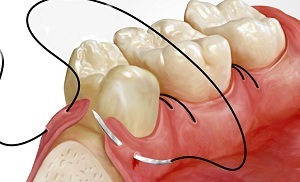 In the direct translation, the term "periostotomy" means an autopsy of the periosteum. This is the standard operation for dissecting( cutting) the periosteum for access to the bone.
In the direct translation, the term "periostotomy" means an autopsy of the periosteum. This is the standard operation for dissecting( cutting) the periosteum for access to the bone.
It is used for opening an abscess and creating an outflow of pus. This medical intervention is carried out in the field of dentistry and is considered a dental preserving procedure.
Contents of
- Indications for prescribing operation
- Methods for anesthetics
- Method for periostomy
- Rehabilitation period
Indications for prescribing operation
Periodostomy is assigned to achieve the following:
- open access to the jawbones;
- create a free outflow of pus from the area of inflammation.
The operation is most often caused by inflammatory processes in the periosteum( periosteum) and the appearance of a flux, which is the swelling of the gums next to the aching tooth and the accumulation of pus. Also, surgical intervention will be justified in the following cases:
- Actinomycosis of the jaw and periosteum .The primary treatment of the foci of infection is carried out, the outgrowth of bone tissue is removed.
- Serous periostitis of the jaw .The pastern is opened to relieve tension in the tissues of the teeth and prevent suppuration.
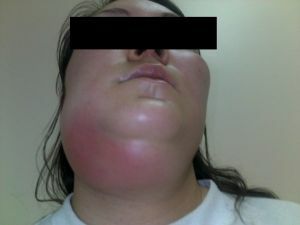
- Inflammatory process after the filling of the tooth channels .The periosteum is cut to prevent possible outflow.
- Purulent periostitis( abscess) .The periosteal is opened to create an outflow of purulent exudate.
- Resection of the upper part of the tooth root .Intervention is carried out as an initial stage of the operation, to access the apex of the root, while the bone tissue is cut after the periosteal incision.
- Other operations on jaw bones .
Methods of anesthesia
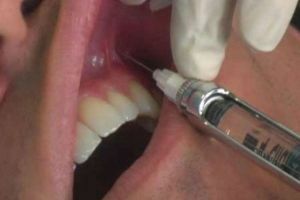 The entire surgical process is performed under local anesthesia. If the upper jaw is interfered with, the anesthesia will be bilateral( infiltration).Anesthetic solution is injected from both sides. Torsal or mandibular anesthesia is performed on the lower jaw( the solution is injected into the area of the lower jaw roller).
The entire surgical process is performed under local anesthesia. If the upper jaw is interfered with, the anesthesia will be bilateral( infiltration).Anesthetic solution is injected from both sides. Torsal or mandibular anesthesia is performed on the lower jaw( the solution is injected into the area of the lower jaw roller).
With extensive purulent inflammation, the effectiveness of anesthesia is reduced. Therefore, it is desirable to use stronger painkillers.
Procedure for periostomy
The intervention process consists, as a rule, of the following steps:
- Local anesthesia.
- Treatment of the oral cavity with antiseptic preparations.
- Cutting and incision of tissues. If the area of the oral cavity is affected, the incision is made along the transitional fold, horizontally. Its length should be sufficient( at least 2 cm) for effective outflow of pus and complete overlap of the infiltrate. In the area of the mandible, the incision is made along the mucous tissue where the seals are most prominent. When the palatine focus of inflammation, the tissue is dissected parallel to the middle line of the palate, in the place of greatest swelling of the infiltrate.
- Pulling and peeling the perioste with a blunt instrument( trowel).
- Flushing of the purulent wound with antiseptic solutions( furacilin, manganese).
- Installation of drainage( rubber plate) to prevent clumping of the wound and better outflow of purulent exudate.
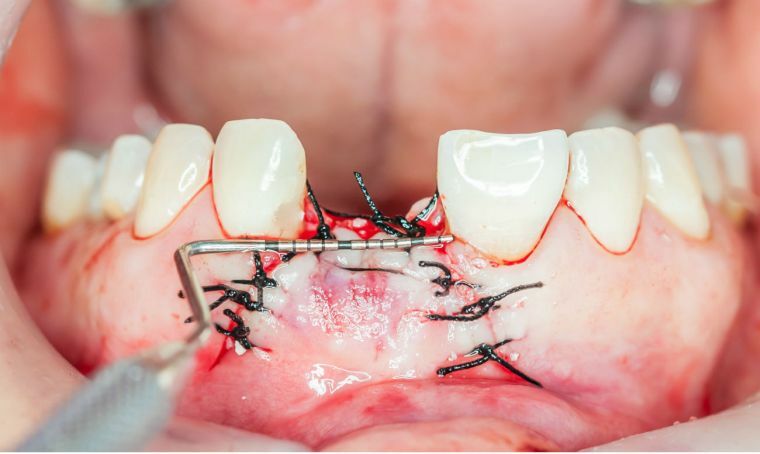
The duration of the operation depends on the complexity of the disease and on average lasts about half an hour.
Complications can occur due to improperly performed surgery:
- improperly installed drainage, which prevents the outflow of pus;
- The location of the incision was incorrectly determined or the tissue was cut too deeply.
To avoid similar results, the operation should be performed by a qualified dentist.
Rehabilitation period
In the first hours after the operation, it is recommended to refuse to eat. The further food should be wiped. 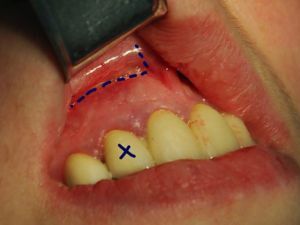
A course of antibiotics and pain medications is mandatory.
Throughout the healing period, the mouth is rinsed with medicines and herbal decoctions.
With prolonged recovery process, physiotherapy( UHF, warming up) and laser therapy can be prescribed.
